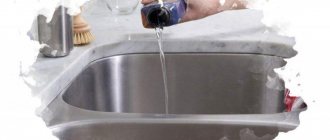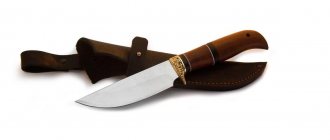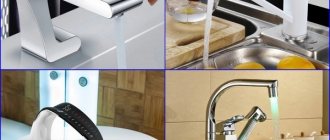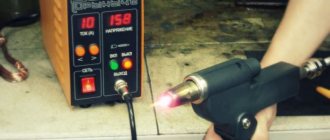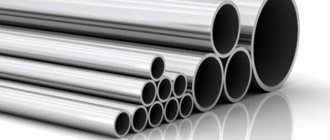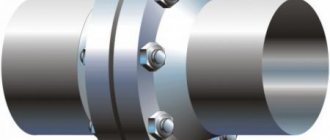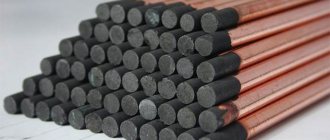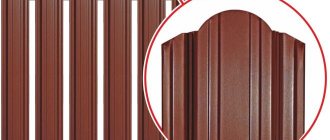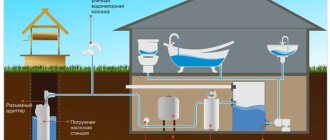Types of pipe cutters by drive type
Pipe cutters for steel pipes are divided into four types according to the type of drive:
- Manual.
This is the simplest pipe cutter design, the operator does not need any special skills to cut steel pipes with a manual pipe cutter. They are easily attached to the cutting area; the operator makes several turns around the pipe and a fragment with a clear cut is obtained. Pros. Easy to use, low price, ideal for one-time local repair work. Minuses. Cutting requires significant physical effort from the operator and is not suitable for intensive work. - Electrical.
Suitable for heavy-duty work, cutting pipes of almost any diameter. A current source of 220/380W is required for operation. Pros. They calmly cope with heavy loads, cut pipes without burrs, and can simultaneously cut a chamfer while cutting. Minuses. Higher cost compared to manual ones. - Pneumatic.
Pipe cutters with pneumatic drive are professional equipment. Pros. They calmly cope with heavy loads, cut pipes without burrs, can simultaneously chamfer for welding, and cut pipes of any diameter and with any wall thickness. Minuses. Higher cost compared to manual pipe cutters, large dimensions and heavy weight; operation requires an expensive compressor. - Hydraulic.
They work on the principle of liquid pressure and require a pump to operate. Pumping through the pump, the liquid acts on the piston and sets the pipe cutter into action. Tools of this class are more powerful than manual ones, but they are inferior to electric devices in all respects. A distinctive feature of hydraulic pipe cutters is the drive, which allows you to cut pipes in confined spaces and even under water, which is very important for the installation of underground communications.
Rice. Types of pipe cutter drives
The choice of pipe cutter depends on the scope of work: for a one-time use, a hand tool will suffice, but for large projects on laying communications it is better to use an electric or pneumatic pipe cutter.
For industrial production, where there are already compressors, pneumatic pipe cutters for steel pipes are most often used. Hydraulic tools are used where high torque is needed, such as cutting thick-walled pipes.
Types of pipe cutters and their prices
According to the type of drive, the pipe cutter is:
Manual
It is used primarily to perform small volumes of work, since cutting occurs using only the operator’s muscular strength.
A characteristic feature is small size and weight, complete silence.
This type of pipe cutter is well suited for use at home, but it should be remembered that during the work it is sometimes necessary to exert significant physical effort.
Electric
The most productive option due to the installed electric motor that rotates the cutting disc.
According to the principle of operation, the closest thing to similar pipe cutters of a classical design is a circular saw or grinder, however, in addition, there is a special fastening system that allows you to fix the mechanism on the pipe in such a way that the result is a strictly perpendicular, even cut.
Any of the electric models is noisy in operation.
A corded pipe cutter also requires connection to a source of electricity.
Its mobile version is a battery-powered tool that allows you to carry out work regardless of the availability of an electrical network at the site.
In general, due to its high productivity, electric pipe cutters are used where it is necessary to cut a large number of pipes with minimal time spent on one cut.
Pneumatic
The operating principle is reminiscent of manual options, but instead of the operator’s physical strength, compressed air is used, pumped by a compressor with an installed receiver.
During operation, such a pipe cutter makes noise, or rather, the compressor makes noise.
Hydraulic
Reminiscent of pneumatic pipe cutters, but instead of air, it uses hydraulic fluid.
In terms of functionality, this type of tool is inferior to electric models; moreover, the characteristic differences include a very large weight.
At the same time, such a pipe cutter has high power, and there are portable and stationary versions.
According to their design features, pipe cutters are:
Scissor
They resemble ordinary metal scissors, however, they have a jaw profile (clip) adapted to the pipe, and a sharpened blade acts as the cutting part.
Scissor pipe cutters are used to cut plastic pipes, both with and without reinforcement.
But they are not suitable for working with metal and thin-walled pipe material, since in the latter case such scissors, pushing through the plastic, lead to its cracking.
The cost starts from 250 rubles.
Options with a ratchet mechanism, which will be discussed below, use a ratchet to ensure the cutting of multilayer metal-plastic pipes without much effort, the diameter of which can reach 100 mm.
Ratchet pipe cutters
The good thing is that actually cutting the material is done not by one, but by several closures of the handles, and the blade returns to its original position immediately after the cut is completed due to a special gear rack.
Using pipe cutters of this design, the material at the end of the pipe can become jammed, bent and lose its original shape.
A calibrator is used to level it, or all adjustments are made manually.
Price from 300 to 3.5 thousand rubles.
Guillotine
Designed to perform an even cut with uniform blade pressure over the entire cross-sectional area.
The guillotine is used mainly for cutting polypropylene pipes; it prevents their deformation.
There are options with a screw feed and a lever that the operator presses on.
In the first case, the diameter of the coverage can reach 225 mm, but as a rule does not exceed 70 mm.
The price for professional models reaches 95 thousand rubles.
Incisive
Made in the form of a gripper with the function of fixing a pipe in which a cutting rotating disk with a mechanism for pulling it towards the material being cut is located.
Such models are suitable for cutting thin-walled and thick-walled polymer and metal pipes.
During operation, the disk gradually cuts the pipe wall in a circle, which occurs by rotating the tool.
The average cost is approximately 1.5 thousand rubles.
Roller
Used for cutting fixed pipes.
The principle of operation is similar to the previous option.
Depending on the design features, such a pipe cutter allows you to cut through pipelines that are pressed to the floor or wall with a gap of 30 mm.
As the tool rotates, its holder gradually tightens, and the rollers, in close contact with the pipe, cut through its walls in a few revolutions.
A tool with one roller allows you to cut pipe material with a diameter of up to 50 mm, and a four-roller tool – up to 100 mm.
After cutting a pipe, burrs may remain on its edges.
Options with wide rollers are suitable for working in tandem with an electric drive, their cost is about 18 thousand rubles.
Varieties of roller models include telescopic ones.
Telescopic pipe cutter
The design has rollers, a carriage and guides, which allows it to be adjusted to a wide range of diameters.
This adjustable cutter often comes with a built-in deburring tool.
Due to the ability to work with a wide range of diameters, this option is also suitable for cutting corrugated stainless steel pipes, as a result of which it received another name - a universal pipe cutter.
The average price is 800 – 1500 rubles.
Rotary pipe cutters with clamp clamp
According to the principle of operation, they resemble the roller version, however, here the pipe in the holder is fixed tightly and on all sides, and is not simply clamped.
Outwardly, they resemble a clamp, pressing tightly against the pipe with rollers on all sides, they ensure cutting through the material along the entire perimeter.
The clamping tool is equipped with removable rollers, and therefore can be easily repaired; it is used only for cutting pipes made of thick-walled steel, the wall thickness of which can reach 19 mm, and only for large-diameter products.
Another advantage of this design is the adjustable handle, which allows you to work in hard-to-reach places.
The cost starts from 170 thousand rubles.
Chain pipe cutter
Designed for cutting brittle materials such as cast iron, concrete or ceramic drain pipes.
The operating principle is no different from a cutting or roller tool.
The design is based on a chain, on the links of which there are cutting rollers, which allows cutting into the part along the entire perimeter, distributing pressure evenly.
The presence of levers allows rotation around the pipe, and a special pressing mechanism serves to smoothly reduce the diameter of the ring formed by the chain as it sinks into the pipe wall.
The minimum cost is 14 thousand rubles for options for 20 - 100 mm.
Orbital
Its design includes shaped cutters.
Used for cutting and chamfering at the same time.
It is a tabletop or floor-standing machine powered by mains or battery power, which contains several jaws for stationary fixation of the workpiece.
The cut occurs by rotating the working part around the pipe.
In turn, such a pipe cutter can be: detachable - to install the material, the clip is opened into 2 halves, one-piece - the cut fragment is inserted inside the non-separable clip.
An orbital pipe cutter is used for cutting workpieces made of non-ferrous and ferrous metals, stainless and plastic pipes.
The price averages 320 thousand rubles.
The portable pipe cutter is a type of orbital model.
Differs in more compact sizes and lower cost.
Mini pipe cutter
As a rule, this is a C-shaped tool with 2 cutting discs.
Because of its compact size, it got its name.
It is used mainly in places with limited space.
Some models of this tool may be highly specialized, that is, designed to perform a specific job, for example:
Pipe cutters without flame cutting
Options with electric or pneumatic drive, often having tensioning mechanisms from a chain, allow cutting without sparks, and are therefore used for processing gas and oil pipelines.
The mechanisms of such tools are designed to operate under heavy loads and cope with pipes with a diameter of up to 3000 mm, where the wall thickness can reach 70 mm.
Refrigerator pipe cutter
Designed for cutting copper, steel and aluminum pipes in refrigeration systems.
This is a mini pipe cutter for diameters, usually 3 - 22 mm (1/8 - 7/8 inch).
Its small size makes it easy to work even in the most difficult to reach places and in very cramped conditions.
Exhaust pipe cutting wrench
In addition to its direct purpose, it is suitable for working with thin-walled metal pipelines with a diameter of up to 75 mm.
The working element is a chain with rollers.
To cut pipes, in most cases, a mechanical pipe cutter is used, that is, a tool with cutting elements that act on the material mechanically.
Pipe cutters for industrial needs produce cuts using other methods:
- Cumulative options - used for explosive cutting of mainly steel pipes with a diameter of up to 1500 mm and a wall thickness of up to 30 mm. These are two rings with shaped charges that cut through the walls with a high-speed cumulative jet.
- A laser tool is a cutter in the form of machine equipment, usually CNC. Used for cutting material, cutting grooves with high speed, sharpness and edge quality. The cut can be made at a variety of angles.
- Plasma pipe cutter - for cutting and cutting pipes from a wide variety of alloys. Most often this is an automatic CNC machine working in conjunction with software.
Classification of pipe cutters for steel pipes by type of cutting elements
Pipe cutters use different cutting devices: cutters, saw blades, rollers, cutters.
Roller pipe cutters
have from 1 to 4 cutting rollers. Depending on the number of rollers, a pipe cutter can cut pipes of different diameters: one roller will cut a steel pipe with a diameter of up to 50 mm, and a three-roller can handle a diameter of up to 100 mm. Roller tools are suitable for working in conditions where it is not possible to make a full rotation of the pipe cutter around the pipe. The disadvantage of roller tools is that it is impossible to obtain a clear cut without roughness; the ends will need to be further processed in the future.
Pipe cutters with cutters.
They are an iron cage that covers the workpiece. Sharp and durable cutters can cut through virtually any material, including thin steel pipes. The moving part of the unit is moved by a threaded rod. Simple models are equipped with only two cutters, and the rod element also serves as a handle. These tools are suitable for cutting metal up to 1 inch (25.4 mm) thick. For pipe material with thicker walls, you will need to buy special cutters. Such tools make it possible to obtain a perfectly smooth cut.
Chain pipe cutters.
This tool resembles a saw with a saw blade; it has a tension mechanism, swivel arms and chains with rollers. A saw-type pipe cutter can effortlessly cut single-layer metal with a cross-section of up to 3 centimeters. Chain pipe cutters work for a long time and reliably, withstand significant loads and provide a smooth cut without roughness. After cutting, the ends of the pipe do not need to be further processed for welding, which significantly saves time during repair and installation work.
Rotary pipe cutter
. The pipe is cut using identical interchangeable rollers that are securely fixed around the product. The pipe cutter is driven by a removable handle, and the working elements reliably and accurately carry out the cut. Advantages of a rotary pipe cutter: quick cutting of pipes with a wall thickness of up to 19 millimeters; The pipe cutter can work in difficult conditions, for example, under water, at the bottom of trenches, in pits, etc. Disadvantage: the high cost of the device, but in industrial production it quickly pays for itself. Suitable for large enterprises engaged in commercial repair, installation, communications and construction activities.
You should purchase a suitable pipe cutter based on the size of the pipe and its wall thickness. You also need to take into account the location of the work and how important it is to immediately obtain a smooth, neat cut that does not require further processing with a beveling machine.
Rice. Cutting elements of pipe cutters
Types of separating elements
Units designed for cutting steel pipes of different diameters differ from each other in the type of element that performs the cutting.
Roller tools consist of 1-4 cutting and several feed rollers. A model with one drive roller allows you to process a steel pipe with a diameter of up to 50 millimeters, and a three-roller model can easily handle a part with a cross-section of up to 100 millimeters.
However, it is extremely rare to obtain a perfect cut without roughness from roller units, and this point is considered the main disadvantage of the equipment.
Tools with a roller cutting element are useful for working in awkward conditions. For example, where cutting is required, but it is not possible to make a full revolution of the device around the part
Cutting devices are an iron cage that covers the workpiece. The high quality and durable material of the working element allows the tool to be used for cutting thin steel pipes. The position of the cutters is additionally adjusted depending on the thickness of the metal and the overall diameter of the pipe. The moving part of the unit is moved by a threaded rod.
Simple models are equipped with only two cutters, and the rod element also serves as a handle. These tools are suitable for processing metal up to 1 inch thick.
For pipe material with thicker walls, you will need to buy special cutters. The main advantage of the units is the ability to obtain a perfectly smooth cut that does not require subsequent countersinking.
Chain modules resemble a chain saw in their operating principle. They have a tensioning mechanism, swing arms and chains with rollers. With a tool of this type, you can effortlessly cut single-layer pipe material with a cross-section of up to 3 centimeters.
Chain pipe cutters work long and reliably, withstand significant operating loads and are famous for providing a smooth, clear cut without roughness. A pipe cut with this tool does not need to be additionally prepared for welding, which means that all repair and installation work can be completed much faster
The rotary pipe cutter operates by means of identical interchangeable rollers that are securely fixed around the product. The unit is driven by a removable handle, and the working elements reliably and accurately carry out the cut.
The main advantages of the device include:
- the ability to quickly cut pipe structures with a wall thickness of up to 19 millimeters;
- effective work in difficult conditions (underwater, at the bottom of trenches, in pits, etc.).
Of the shortcomings, only one stands out - the high cost of the device, but in industrial production it quickly pays off. Therefore, price does not become a stumbling block for owners of large enterprises engaged in commercial repair, installation, communications and construction activities.
You should purchase a suitable pipe cutter taking into account the size of the pipe you will have to cut, where exactly the work will be done and how important it is to immediately obtain a smooth, neat cut that does not require further finishing.
Design features of the clamping unit
The clamping unit can be presented in three types: clamp, lever and screw
.
- Clamp clamp
pipe cutters work quickly and cleanly, withstand heavy loads and handle pipes up to 12 inches thick and up to 324 mm in diameter. They have one long handle and one auxiliary one. This design allows the operator not to put extra effort into cutting, and the equipment can be adjusted directly during operation. Clamping devices completely cover the part during cutting, the load is distributed evenly over the entire area and cutting occurs almost perfectly. The advantage of clamp pipe cutters is that a full rotation of the device around the pipe is not necessary and cutting of material can be carried out in cramped conditions, limited spaces and even by the rolling method. - In lever
models, the part is fixed by pressing the lever. - In screw
parts, the part is held in a constant position by screw elements. To prevent the pipe walls from being crushed during processing, the part is clamped medium-strong and held in this position until cutting.
Rice. Pipe cutter clamping mechanisms
How to choose a blade for a tool
For a high-quality cut, the pipe cutter blades must have a hardness that is 15...20 HRC higher than the hardness of the pipe being processed. This parameter can be determined using a “spark test”. It will reveal the approximate percentage of carbon and help determine molybdenum, tungsten and manganese. Thanks to this method, you can understand the initial hardness and grade of pipe steel.
For cutting alloy and non-alloy steel pipes, we recommend purchasing a set of cutters of varying hardness.
How to determine the hardness of a pipe material
To carry out the test, the end part of the part is processed on an emery grinder and the spark generated in the process is carefully examined:
- A more continuous sparkling beam of light yellow color means low-carbon non-alloy steel;
- A medium-carbon composition is indicated by a beam of the same color, but more branched, with a certain number of bright flashes;
- Standard quality steel produces a fine spark stream with short branches and virtually no flash;
- Alloy steel has increased strength and is not prone to brittle fracture. The stream of sparks is deep yellow, and instead of light flashes, elongated shiny arrows are observed.
Having detailed information about the quality of the steel from which the pipe requiring processing is made, choosing the appropriate cutting equipment will be easy and quick.
Manual cutting technology
The cutting tool blade must have a hardness that is 15-20 HRC higher than the hardness of the workpiece material . Therefore, if the operator does not know the characteristics of the material being processed, then the steel pipe can be assessed using the spark test method.
To do this, you need to process the end of the steel workpiece on an emery machine, while controlling the nature of the beam of sparks escaping from the machine tool. Thus, the percentage of carbon content is determined, and therefore the hardness of the material:
- With unalloyed low-carbon steel, sparks will fly out in a continuous beam of light yellow color.
- For unalloyed medium carbon steel, the color remains the same, but the presence of branches and brighter flashes of the beam will increase.
- For steel of ordinary composition, the spark beam will be thinner, and the branches will be short. There are practically no flashes.
- For alloy steel, the sparks will become a deep yellow hue, and instead of flashes, arrows will be observed stretched along the flow of sparks.
The same method can be used to identify molybdenum, tungsten and manganese. Based on the hardness of the material, the required hardness of the cutting tool can be effectively determined.
The cutting process, regardless of the technical properties of the pipe cutter, has the same sequence:
- During preparatory work, it is necessary to determine whether the workpiece meets the equipment parameters in terms of its characteristics. And also how possible it is to get the job done with this tool (cut angle, accuracy).
- To install the equipment on the surface of the workpiece, turn the handle counterclockwise to expand the clamps to the required distance. Then the tool is placed on the workpiece, at the pre-marked location of the upcoming cut, and we turn the handle clockwise until the cutting plane of the roller comes into contact with the surface of the part.
- We form a guide groove by slightly pressing the cutting roller into the surface of the workpiece. And then we turn the tool a full turn so that the cutting edge of the tool creates a small groove in the pipe.
- Next, we carry out the cutting process itself. After creating the guide groove, you need to turn the screw 90° to clamp the cutting tool to the surface of the workpiece. Rotate the tool while simultaneously tightening the screw until the part is completely cut off.
To protect the cutting tool, do not press the roller into the part with great force.
How manual models work
In everyday life, cutting steel pipes is most easily done with a roller pipe cutter. This tool has several circular knives and can easily handle material with a diameter of up to 100 millimeters.
Types of manual pipe cutters
To cut pipes of various diameters, different types of pipe cutters are used:
- Pipes with a diameter of up to 100 mm.
For household work cutting steel pipes, use a roller pipe cutter. It has multiple disc cutters and easily cuts pipes up to 100 millimeters in diameter. It is not suitable for cutting steel pipes with a diameter greater than 100 mm, since significant efforts will have to be made, and it is unlikely to achieve an ideal cut. - Pipes with a diameter of 150 mm.
We recommend cutting large diameter pipes of 150-900 mm with a rotary pipe cutter. It is equipped with a telescopic mechanism responsible for turning the cutting rollers, thanks to which it can cut pipes in cramped conditions of pits, excavations and trenches. In a rotary pipe cutter, rollers are attached to the outer perimeter of the pipe. When acting on a lever with a mechanical amplifier, they are pressed against the surface of the pipe and make a clear, even cut without nicks.
Rice. Manual pipe cutter for large diameter pipes
Manual pipe cutters are suitable for small jobs. For large-scale repair and installation work, use pipe cutters with electric or pneumatic drive.
Kinds
Varieties of pipe cutters are classified depending on the objects being cut and the characteristics of the cutting element. Accordingly, the following types of tools are distinguished:
- The cutter cuts pipes up to 100 mm in diameter. Suitable not only for steel, but also for plastic pipes, Has several steel discs.
- The chain one is distinguished by the fact that it can cut pipes made of dense materials (cast iron, concrete, ceramics), since it has a mechanism for tightly fixing the cutting object, made on the basis of a conventional chain and rotary levers.
Video instructions: how to work with a pipe cutter.
- The roller is equipped with cutting rollers (from 1 to 3) and guide elements, and the diameter of the pipes that it can cut directly depends on the number of rollers: a device with 1 roller cuts pipes up to 50 mm, and with 3 rollers – up to 100 mm and even more .
- The telescopic one has a carriage, roller and guides that can optimally fix the pipe depending on the required cutting angle. It copes well with cutting thick pipes or made of durable materials, since due to the configuration it can create strong pressure on the surface of the cutting object.
- The ratchet pipe cutter is portable and can cut thin pipes. Its design is the simplest among devices of this class - 2 handles and a cutting blade.
- Electric is equipped with an electric motor. Thanks to this, the worker’s effort in cutting the pipe is minimal - it is only important to configure the tool correctly, and he will do the rest of the work almost independently.
- Guillotine got its name because of the design of the cutting mechanism. Its knife makes a perpendicular cut in pipes of small diameters (up to 30 mm). The pipe is fixed in the frame, and the screw pushes the guillotine and makes a clear cut at an angle of 9 degrees. The tool is suitable for cutting pipes of different thicknesses and structures (single-layer, multi-layer, reinforced).
- A pneumatic pipe cutter is driven by rarefied air pressure. This device is used in production for cutting pipes with very large diameters (up to 1500 mm). At the same time, it copes well with cutting dense materials (cast iron) and light plastic.
- Orbital pipe cutters are designed not only for mechanical cutting of pipes, but also for chamfering thin-walled pipes. For this purpose, they are equipped with special chamfer cutters.
At the same time, it is a universal tool - it cuts pipes of any diameter and from any material. Application is limited only by engine power. However, such a pipe cutter also has a significant drawback - it will be inconvenient to use in hard-to-reach areas of work (for example, sewer pipes).
With its help, you can not only carry out mechanical cutting of pipes, but also carry out work on their trimming, chamfering with blunting, as well as from the outer surface of the pipe.
Video overview of one of the models
Often, add-ons are offered for various types of pipe cutters to ensure the safest conditions for working with pipes. Thus, using the quick crimping mechanism, you can quickly secure large pipes in the device without using a special screw. The pipe cutter can also be equipped with additional removable cutting elements designed for pipes of various thicknesses, and rollers that move the device around the pipe.
What are the types of electric and pneumatic pipe cutters?
When it is planned to lay a large-scale communication system or carry out global repair and installation work, industrial tools are used: electric or pneumatic pipe cutters. They are equally suitable for production and field work, and process pipe as quickly and cleanly as possible. Most models of automatic industrial pipe cutters simultaneously remove a chamfer while cutting, preparing it for further welding.
Automatic pipe cutters are divided by type of design into pneumatic, electric and hydraulic.
The main difference between electric pipe cutters and pneumatic ones: dimensions. Due to their compact drive, pneumatic pipe cutters are much smaller in size and weight than electric ones.
- An electric pipe cutter operates from a regular outlet. When cutting pipes far from power grids, the pipe cutter can be easily connected to a gasoline or diesel generator.
- A compressor is required to operate a pneumatic pipe cutter.
- To operate a hydraulic pipe cutter, you need a hydraulic station.
Automatic pipe cutters are divided into one-piece and detachable according to the type of design.
Rice. Two types of designs of automatic industrial pipe cutters
One-piece pipe cutters
are located at the end of the pipe and are fixed using a self-centering clamp. They have compact dimensions and do not require a large space around the pipe.
- One-piece devices are quickly mounted on a pipe element and have the ability to qualitatively cut both thin-walled and thick-walled (up to 100 mm) parts made of alloy and non-alloy steel
- Split machines for cutting steel pipe material are easily attached anywhere in the pipeline.
- The device consists of interchangeable modules and is placed on the outer part of the surface.
- Despite the fact that the working elements occupy minimal space around the pipe, the cut when cutting is very accurate and does not require additional processing.
Rice. One-piece pipe cutters
Split electric pipe cutters
not only do they cut steel pipes into fragments of the required size and make trims, but also remove the chamfer from the top edge.
- The cutting element in the pipe cutter is a pair of cutters; the operation of the tool is activated by an electric or pneumatic motor, depending on the drive.
- Thanks to its two-part detachable body, the split pipe cutter can be placed on a functioning pipeline and quickly eliminate sudden breakdowns and carry out repairs of any complexity.
- To increase the processing speed, one of the cutters is attached to the edge of the pipe, and the second one cuts a chamfer during the process. The device is fixed with special cams. Usually there are from 4 to 8 pieces.
Rice. Split pipe cutters
Automatic pipe cutters with electric and pneumatic drive can provide an accurate cut without burrs; in most cases, they are equipped with an additional cutter for chamfering and can carry out two operations simultaneously: cutting the pipe and chamfering the end. In rare cases, pipe cutter models are equipped with additional options for boring pipes for welding.
For complete control of all processes, the device is equipped with a servo drive. It makes it possible to closely monitor the torque and timely adjust the speed of cuts.
Pipe cutter for steel pipes - device and principle of operation
This device is the best tool for precise cutting of pipes at right angles.
The simplest pipe cutter for steel pipes consists of the following elements:
- A cutting roller, which can be of different types depending on the characteristics of the pipe that is supposed to be cut.
- A clamp for rigidly attaching the roller to the frame and a housing for its placement.
- The frame is the base in which the roller is placed.
- Feed handle - it is used to rotate and cut the pipe.
The device is shown schematically in the figure below (disassembled).
The steel pipe cutter works by applying the mechanical force of rotation of the feed screw. The pipe is fixed in the frame and secured with clamps on both sides. The screw begins to rotate, as a result of which a groove is formed in the pipe wall, which deepens until the pipe is completely cut. In this case, the screw of pipe cutters with one roller is turned a full turn (360 degrees), and devices with 4 rollers are rotated 120 degrees, since each of them cuts off its own piece of pipe.
IMPORTANT. In some cases, special metal hacksaws are used to cut pipes. This is especially convenient when you just need to get 2 or more pieces from one product. However, if smooth edges and right angles are required (this is especially true for subsequent threading), then a pipe cutter for steel pipes is the only tool that can do such a job.
How to cut small diameter pipes
For cutting small-diameter steel pipes in everyday life, hand tools are most often used. A manual roller pipe cutter is the most convenient and practical option for processing small-diameter steel pipes at home. To use it, you do not need professional skills or knowledge.
Rice. Manual pipe cutters
- The pipe is secured with the clamping mechanism of the pipe cutter; the handle of the pipe cutter is turned clockwise so that the cutting roller comes into contact with the metal surface.
- Then make another turn of the handle, making sure that the beginning and end of the cut line touch and create a closed circle without interruptions or distortions.
- If this step is completed, the adjusting handle of the tool is moved another half turn and the cutting element is pulled closer to the pipe.
- When the cutters clearly enter the metal, the scrolling is accelerated a little and the handle is rotated until cutting occurs.
For work in flow mode at large enterprises, we recommend using one-piece pipe cutters with electric or pneumatic drive. They are perfect for quick automatic cutting of pipes with a diameter of 14 mm.
Which pipe cutters are better
Having considered all the characteristics, we can conclude that a pipe cutter for stainless steel pipes is the best for them. A tool for cutting plastic is not at all suitable for working with metal, and a pipe cutting machine is poorly suited for cutting thin copper pipes.
It is worth choosing according to the principle of what is needed in a particular case. If we are talking about home repairs of the heating system, you don’t have to buy a pipe cutting machine, but limit yourself to a hand-held roller tool.
Naturally, a pipe cutter for stainless steel pipes is not intended for cutting cast iron. In this case, you can simply use a grinder.
To install the air conditioning system, you will need pipe cutters for soft metal, namely roller pipe cutters.
It must be remembered that the cutting element quickly grinds down and becomes dull. Even the best tool can be disappointing if you don't follow the instructions.
Instructions for use:
- Secure the pipe.
- Draw a cutting line.
- Check the serviceability of the device.
- Wear personal protective equipment: glasses, gloves.
- Attach the tool to the pipe.
- Ensure tight contact between the tool and the cutting plane.
- Ensure the movement of the pipe cutter relative to the pipe.
- After finishing cutting, remove chips and burrs from the ends of the pipe.
These are general rules. Of course, a pipe cutting machine works differently, and the instructions for it should be slightly different. Instructions for its use are included with each purchase. Begin operation by reading the instructions.
Cutting large diameter steel pipes
In everyday life, cutting steel pipes with a diameter of more than 400 mm is not necessary; such large pipes are processed with a special industrial tool. In addition to the electrically or pneumatically driven pipe cutters described above, laser and gas cutting machines can be used.
Rice. Pipe cutting machines
The laser machine can cut steel pipes with large diameters and large wall thicknesses effortlessly and at high speed. Laser machines are usually equipped with CNC and, through a computer control system, the operator can set the machine the desired program for cutting of any complexity.
If you need to make a single section of pipe with a diameter of more than 400 mm, it is not necessary to purchase professional equipment. You can use a regular grinder: you need to install a cutting element for metal on it and make a careful cut.
Rice. Cutting pipes with a grinder
When cutting large-diameter steel pipes, it is not recommended to place a working element for wood or stone on the grinder. A discrepancy between the density of the cutters can cause damage to the workpiece and lead to breakage of the tool itself/
The grinder is suitable only for one-time cutting and cutting work. For regular large-scale events, it makes sense to acquire a more durable and powerful instrument. Rules of operation and care
How to care for a pipe cutter
In order for the pipe cutter to serve for a long time and reliably, to perform high-quality cutting and not to damage the pipe walls during operation, it is very important to choose the optimal level of clamping of the steel part. Do not tighten the workpiece too much. This can cause a discrepancy between the beginning and end of the cut line, creating an unaesthetic appearance of a screw thread on the part.
If the steel pipe is clamped in the pipe cutter clearly, but not too tightly, the cutting will take place quickly, there will be no screw mark left on the part, and the edge will come out smooth and even.
The rotation of the mechanism should be carried out evenly and not too quickly. Otherwise, the walls will collapse and excess cut metal will form at the cut-off point.
- For correct and long service after work, the surface of the cutting roller, feed screw and guide rollers are cleaned with a special product and then treated with lubricant.
- The outer surface is inspected for dents or other damage, and chips are sanded so that they do not interfere with subsequent work.
- The cutting elements (cutter or roller) are inspected for dullness and, if necessary, immediately replaced.
- For storage, the pipe cutter is left in a dry and warm place.
- After such procedures and comfortable storage conditions, the device will remain operational for a long time and will easily cope with all tasks.
Video tutorials on cutting pipes in different ways
Reed pipe clamp cutter
How a pipe clamp cutter works: detailed video instructions on how to use a manual pipe cutter equipped with a clamp latch. The reliable unit has good power and copes with parts with a diameter from 32 to 365 mm. It is used not only in stationary premises, but also under water, in deep pits or places where increased noise is unacceptable (residential buildings, pipe racks, etc.).
Manual roller pipe cutter
Cutting steel pipes with a roller pipe cutter: the video clearly shows the process of cutting steel pipe material with a diameter of 3 to 150 mm with a roller unit. The manual model copes well with one-time work, while the electric model is suitable for larger repair and installation projects.

